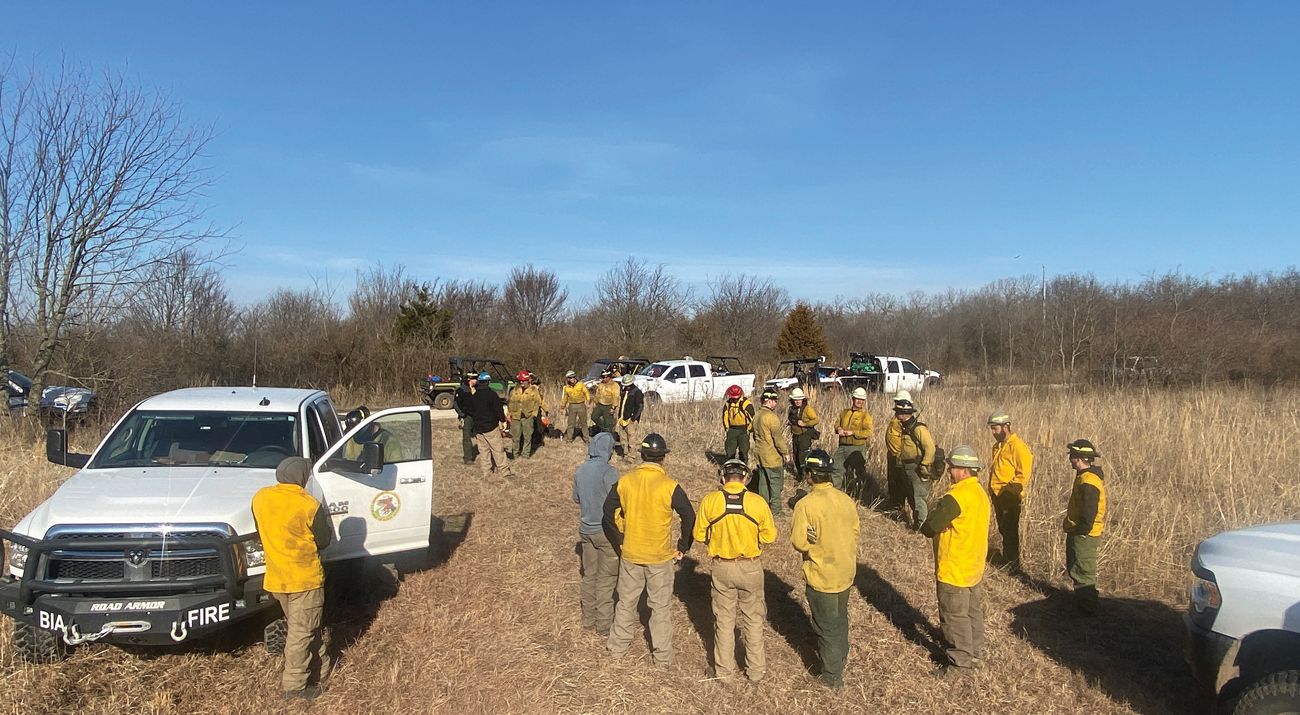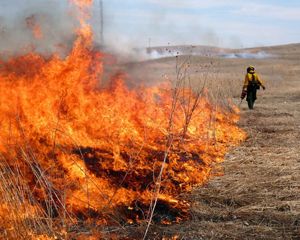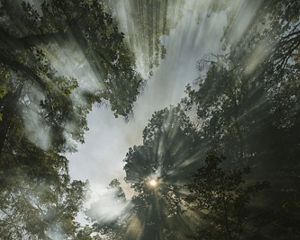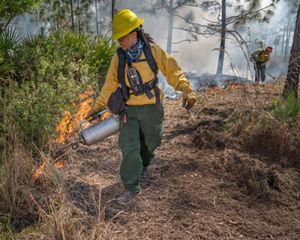Key Takeaways
The Cheyenne and Arapaho Tribes, Chickasaw Nation and Bureau of Indian Affairs partnered with The Nature Conservancy in Oklahoma to conduct controlled burns at the J.T. Nickel Family Nature & Wildlife and Pontotoc Ridge Preserves. With collaborative partnerships, land managers across the state are meeting conservation goals to ensure a healthy, resilient land for generations to come.
As the sun rises over the thick Ozark forest early one spring morning, Jeremy Tubbs is eager to get to work. After designing the burn plan and waiting for the weather to cooperate, today is the day he can safely use his drip torch to implement one of the greatest conservation tools we have for restoration and resiliency: a controlled burn.
Jeremy is a burn boss and the director of the J.T. Nickel Family Nature & Wildlife Preserve. He led this controlled burn, also called a prescribed fire, in spring 2021 with the support of seven staff and volunteers from The Nature Conservancy (TNC) in Oklahoma and three members from the Cheyenne and Arapaho Tribe’s Fire Management Team.
Quote: Jeremy Tubbs
We would not have been able to conduct this controlled burn without the support of the Cheyenne and Arapaho Tribes. We needed a 10-person crew and with their fire team members we had the capacity to conduct this 1,023 acre burn.

The following day and a few hundred miles south, TNC partnered with the Chickasaw Nation and the Bureau of Indian Affairs (BIA) to conduct a burn at the Pontotoc Ridge Preserve near Ada.
"We are pleased to join in this effort to protect and preserve the natural resources vital to the environmental health and economic prosperity of our local communities for generations to come,” says Chickasaw Nation Governor Anoatubby. “As Chickasaws, we have always valued our close connection to nature and our responsibility to exercise responsible stewardship over our resources."
“We believe that TNC’s mission of safeguarding nature and advancing science is a nice complement to our work here as their resources bring a body of knowledge, expertise and educational resources that benefit all partners,” says Robyn Broyles, public affairs specialist with the BIA.
Fire: The Greatest Conservation Tool
Indigenous Nations have long known and utilized fire to stimulate the land and wildlife, but Phillip Daw, assistant fire management officer for the Cheyenne and Arapaho Tribes and a 2023 TNC Conservation Champion, expands fire’s importance beyond land management and explains that “we use it and need it for everything we do.”
“Like water, fire is life,” says Daw. “From keeping us warm to cooking our food. The tribes view fire as a living being. It needs to eat and breathe. It has a personality by being good and bad. The tribes have always had a great respect for fire, and we know the power it has.”
“In modern day, fire is considered bad and is underutilized,” says Daw. Conservation stewards and fire practitioners “are trying to show that fire can be good if properly managed along with healthy land management practices and are actively promoting good fire in modern times as a resource tool,” says Daw.
Quote: Phillip Daw
Every region across the state requires varying frequencies of fire or disturbance. The J.T. Nickel Family Nature & Wildlife Preserve in the Ozarks needs regularly controlled burns to reduce leaf litter and other vegetative debris that collects on the forest floor. Dried out debris can provide dangerous fuel for catastrophic wildfires like those increasingly seen dotting the West Coast, blocking out the sky with smoke. Burns also support the native plant life and keep more invasive species like the highly flammable eastern redcedar tree from becoming dominant throughout the landscape.
The Pontotoc Ridge Preserve is closer to central Oklahoma in the cross timbers and southern tallgrass prairie regions. When managed with fire, this biologically diverse habitat is more likely to be resilient to extreme weather events, provide refuge for native wildlife and in turn support a range of human benefits like protecting the Arbuckle-Simpson Aquifer—the precious water supply for thousands of people in Ada, Sulphur, Davis, Tishomingo and Durant.
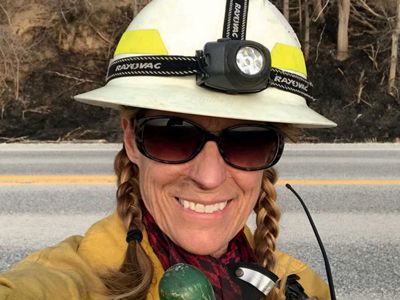
“Controlled fire has been inconsistent at our preserves in the Arbuckle Plains,” says Jeanine Lackey, former director of the Pontotoc Ridge Preserve and current preserve manager at Pearl Jackson Crosstimbers Preserve. “Because of these valuable partnerships, we can increase the conservation successes in the entire region and position ecosystems to thrive under future climate conditions by restoring areas likely to remain suitable as the climate changes.”
Working Together to Do More
Each controlled burn requires precise coordination, where an agile fire team can operate in tandem to conduct the burn safely and effectively. But that’s only half the process. Before lighting the fire, burn bosses at each preserve spend weeks planning, organizing, coordinating, and then waiting on a 24-hour call notice for the right weather conditions. If you’ve been in Oklahoma long, you know that the weather can be unpredictable, which makes managing a group of 10 to 20 people traveling from each corner of the state a trophy-worthy accomplishment of its own.
Phillip Daw, along with Nokuse Scott and Nathaniel Charley, fire practitioners of the Cheyenne and Arapaho Tribes, traveled more than 200 miles from tribal headquarters in Canadian county to eastern Oklahoma near Tahlequah. Twenty-three BIA and tribal practitioners made their way from as far as Oregon, Washington and Colorado to the preserve near Ada. Each crew brought multiple fire engines and truckloads of various equipment.

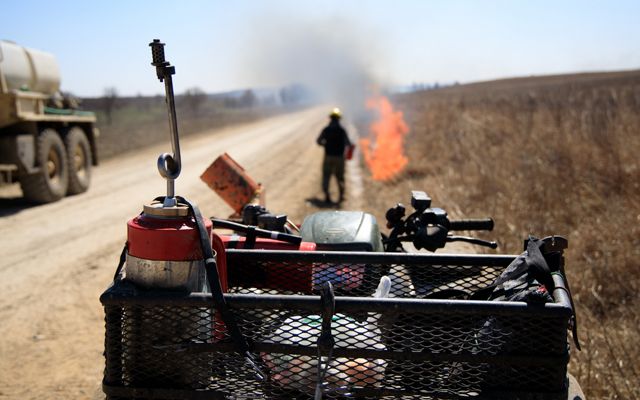
“The Cheyenne and Arapaho Tribes Fire Management is looking to achieve a solid land manager partnership in conservation,” says Daw. “It’s not easy to maintain a burn program with all the factors that go into a successful burn, and sometimes we need outside help as land managers. By helping each other, we are all able to achieve conservation goals that will benefit future generations to come.”
Directors Bob Hamilton and Chris Hise with the Joseph H. Williams Tallgrass Prairie and Four Canyon Preserves traveled from Osage and Ellis counties to participate as well. But the work doesn’t end after one day of burning. TNC staff and tribal partners overnighted at the preserves to manage post-burn mop up operations. This is where the fire crew patrols the burn site extinguishing any lingering hot coals to ensure the fire is completely out.
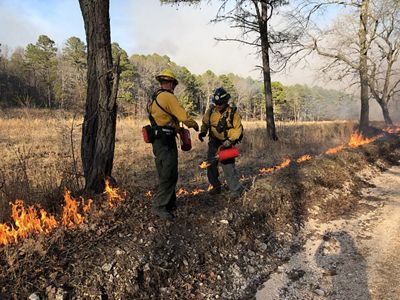
Combining Science with Generational Knowledge
Many hands make light work. Collaborative partnerships and programmatic resources like the Reserved Treaty Rights Lands (RTRL) provide a system to incorporate Tribal Nation’s priorities of reducing wildfire risk and promoting ecosystem health with conservation work conducted by local entities.
“The RTRL program is an excellent resource that allows the BIA, tribes, other federal and state entities, non-profit organizations, special interest groups, and private landowners the financial avenue to work together to meet common goals,” says Broyles. “This project allows us to reduce the potential for large catastrophic wildfires and promote the enhancement of our natural resources that many Native people use in their daily lives.”
Lasting conservation success depends on collaboration. Learnings from rigorous science paired with generational knowledge and wisdom from Tribal Nations are pillars in understanding, respecting and managing the natural world.
Support Controlled Burns in Oklahoma
Show your Okie pride by sporting a speciality license plate on your car or make a donation to continue conservation efforts across the prairie.
